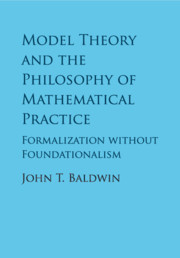Book contents
- Frontmatter
- Dedication
- Contents
- List of Figures
- Acknowledgments
- Introduction
- PART I REFINING THE NOTION OF CATEGORICITY
- PART II THE PARADIGM SHIFT
- 4 What Was Model Theory About?
- 5 What Is Contemporary Model Theory About?
- 6 Isolating Tame Mathematics
- 7 Infinitary Logic
- 8 Model Theory and Set Theory
- PART III GEOMETRY
- PART IV METHODOLOGY
- References
- Index
4 - What Was Model Theory About?
from PART II - THE PARADIGM SHIFT
Published online by Cambridge University Press: 19 January 2018
- Frontmatter
- Dedication
- Contents
- List of Figures
- Acknowledgments
- Introduction
- PART I REFINING THE NOTION OF CATEGORICITY
- PART II THE PARADIGM SHIFT
- 4 What Was Model Theory About?
- 5 What Is Contemporary Model Theory About?
- 6 Isolating Tame Mathematics
- 7 Infinitary Logic
- 8 Model Theory and Set Theory
- PART III GEOMETRY
- PART IV METHODOLOGY
- References
- Index
Summary
Pillay writes,
The notion of truth in a structure is at the centre of model theory. This is often credited to Tarski under the name Tarski's theory of truth. But this relative, rather than absolute, notion of truth was, as I understand it, already something known, used, and discussed. In any case, faced with the expression truth in a structure there are two elements to be grasped. Truth of what? And what precisely is a structure? [Pillay 2010]
We defined the notions Pillay refers to in Chapter 1. In this chapter we consider his questions more closely and consider some key episodes in the development of the notion of a first order theory as a focal point.
The Downward Löwenheim–Skolem–Tarski Theorem
The meaning of ‘contradictory’ underwent a vast change in the early decades of the twentieth century. It is important to read the famous letter from Hilbert ([Frege & Hilbert 1980], 39) in the 1899–1900 Frege–Hilbert correspondence as written by the turn-of-the-century Hilbert not the later Hilbert:
if the arbitrarily given axioms do not contradict one another with all their consequences, then they are true and the things defined by the axioms exist. This is for me the criterion of truth and existence. The proposition ‘Every equation has a root’ is true, and the existence of a root is proven, as soon as the axiom ‘Every equation has a root’ can be added to the other arithmetical axioms, without raising the possibility of contradiction, no matter what conclusions are drawn. ([Frege & Hilbert 1980], 39)
As we observed on page 33, the Hilbert writing this passage has not yet made the distinction between formal and informal language. Today we might replace ‘do not contradict one another’ by ‘do not imply 0 = 1 in an ambient formal system’ and the word ‘true’ by ‘satisfiable’ and read the first sentence as an instance of Gödel's completeness theorem for first order logic. Such replacements are anachronistic in several respects; not only has a formal sentence entered the discussion but it assumes the first/second order distinction.
- Type
- Chapter
- Information
- Model Theory and the Philosophy of Mathematical PracticeFormalization without Foundationalism, pp. 89 - 118Publisher: Cambridge University PressPrint publication year: 2018



